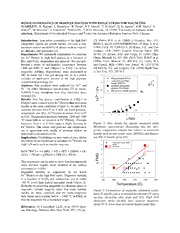
NASA Technical Reports Server (NTRS) 20120013829: Redox Systematics of Martian Magmas with Implications for Magnetite Stability PDF
Preview NASA Technical Reports Server (NTRS) 20120013829: Redox Systematics of Martian Magmas with Implications for Magnetite Stability
REDOX SYSTEMATICS OF MARTIAN MAGMAS WITH IMPLICATIONS FOR MAGNETITE STABILITY. K. Righter1, L. Danielson2, K. Pando2, R.V. Morris1, T. G. Graff2, D. G. Agresti3, A.M. Martin1, S. Sutton4,5, M. Newville5, A. Lanzirotti5, 1NASA/JSC, 2ESCG, Houston, TX 77058, 3University of Alabama at Bir- mingham, 4Department of Geophysical Sciences and 5Center for Advanced Radiation Sources, Univ. Chicago. Introduction: Iron redox systematics of the high FeO [2] Morris, R.V. et al. (2008) J. Geophys. Res., 111, shergottitic liquids are poorly known, yet have a fun- E02S13, doi:10.1029/2005JE002584; [3] Bajt, S. et al. damental control on stability of phases such as magnet- (1994) GCA 58, 5209-5214; [4] Kress, V.C. and Car- ite, ilmenite, and pyroxenes [1]. michael, I.S.E. (1991) Contrib. Mineral. Petrol. 108, Experiments: We undertook experiments to constrain 82-92; [5] Mysen, B.O. and Virgo, D. (1985) Phys. the Fe3+/Fe(tot) in high FeO glasses as a function of Chem. Mineral. 12, 191-200; [6] O’Neill, H.St.C et al. fO , melt P O , temperature and pressure. We also per- (2006) Amer. Mineral. 91, 404-412; [7] Toplis, M.J. 2 2 5 formed a series of sub-liquidus experiment between and Carroll, M.R. (1995) Jour. Petrol. 36, 1137-1170; 1100 and 1000 °C and FMQ+0.5 to FMQ-1 to define [8] McCoy, T.J. and Lofgren, G.E. (1999) Earth Plan- magnetite stability. Experiments were performed at et. Sci. Lett. 173, 397-411. JSC in either the 1 bar gas mixing lab, or in a piston cylinder or multi-anvil presses in the high pressure experimental petrology lab. Analyses: Run products were analyzed for Fe3+ and Fe2+ by either Mössbauer spectroscopy [2] or micro- XANES (x-ray absorption near edge structure) spec- troscopy [3]. Results: One bar glasses equilibrated at FMQ-3 to FMQ+3 show a much lower Fe3+/Fe(tot) than terrestrial basalts at the same conditions (Figure 1). As melt P O 2 5 contents increase from 0 to 3 wt% (at fixed pressure, temperature and fO ), Fe3+/Fe(tot) decreases from 0.07 2 to 0.05. Temperature increases between 1200 and 1500 °C cause little to no variation in Fe3+/Fe(tot). Pressure increases from 1 to 4 GPa cause a slight decrease in Figure 1: New results for glasses measured using Fe3+/Fe(tot). The trends with pressure and temperature Mössbauer spectroscopy illustrating that the sher- are in agreement with results of previous studies on gottite composition remains low relative to terrestrial terrestrial compositions [4-6]. basalts such as mid ocean ridge (JDFD2) and Hawai- Implications: Combining our new series of data allows ian (Kil-2) basalts (from [4]). derivation of an expression to calculate Fe3+/Fe(tot) for high FeO melts such as martian magmas. ln(Fe3+/Fe2+) = = a lnfO + b/T + cP/T + dXFeO + eX- 2 Al O + fXCaO + gXNa O + hXK O + iXP O 2 3 2 2 2 5 This expression can be used to show that decompressed melts become slightly more oxidized at the surface (compared to 4 GPa). Magnetite stability is suppressed by the lower Fe3+/Fe(tot) of the high FeO melts. Magnetite stability is a function of Fe O and temperature and is stable 2 3 ~50 °C lower than typical terrestrial basalt (Figure 2). Difficulty in producing magnetite as a liquidus phase in magmatic systems suggests either that many martian Figure 2: Comparison of magnetite saturation condi- basalts are more oxidized, that the titano-magnetite tions (T and fO ) for a terrestrial ferrobasalt [7] and a 2 only forms upon cooling below ~ 1000 °C at FMQ, or martian shergottite (this study and [8]). High FeO that the magnetite has a secondary origin. shergottite melts (dashed line) saturate magnetite about 50 °C lower than terrestrial basalt (solid line). References: [1] Carmichael, I.S.E., et al. (1974) Igne- ous Petrology, McGraw-Hill, New York, NY, 739 pp.;
